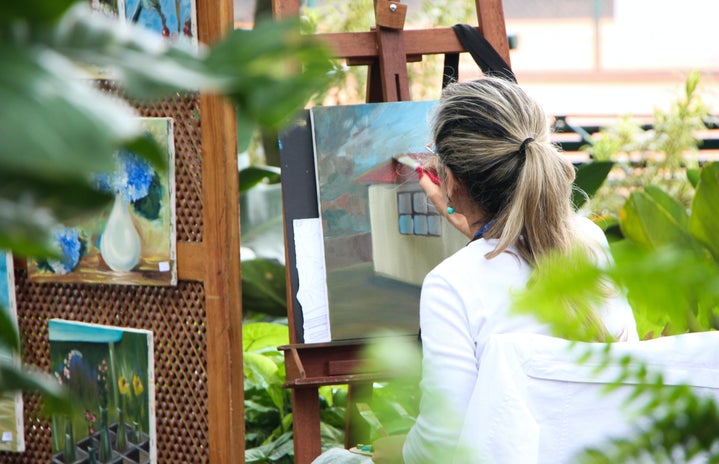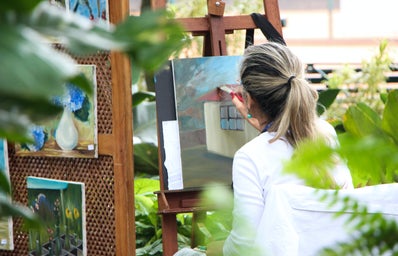1. Decide on a character
The one thing I knew while trying to decide on a costume was that I DID NOT want to wear a wig. They’re itchy and hot and overall a bad idea if you’re looking to be both cute and comfortable. There aren’t that many characters with short-ish brown hair so already my options were somewhat limited.
In the end I decided to go with Rapunzel post haircut. Even though that’s the way she finishes the movie, everyone wants to go with long hair Rapunzel for a costume. Short hair Rapunzel doesn’t get enough love!
Photo Source: Flickr
2. Look at reference pictures
Start looking at pictures of the character and looking at the costumes that other people have made to get an idea of the colors of the fabric and the particulars of the costume.
I looked at Pinterest a lot and at other people’s costumes! For Rapunzel, someone had made a costume guide that explained all the different pieces of what Rapunzel wears to help me break it down for my own costume.
3. Find a pattern (or make one!)
If you can find a sewing pattern that’s made for you character’s costume then that’s one less thing to worry about! But it’s not always easy to find a good pattern so you might have to modify one that you have (or one that you buy) to get the right fit.
I couldn’t find a good pattern for a Rapunzel costume, so I used a pattern that I already had and modified the neckline to make it look more like Rapunzel’s outfit. I also had to find a skirt with seams and a panel in the front that I could make a different pattern and fabric.
Pattern papers look very confusing but they’re not especially confusing (unless they’re in German like mine are and you can’t read German, which I can’t)
If you have fabric that you can practice on, then do! It’s better to make a mistake in fabric you don’t care about than to ruin the fabric you like and want to use for your costume.
4. Find fabric
Once you have a pattern, you can start looking for fabric! Your pattern will usually tell you how much fabric to buy to make your piece. Make sure to bring a reference picture with you to try to get fabric that matches your color scheme as closely as possible.
I went to the Fabric Warehouse in Rahway when they had their Memorial Day sale to get the best deal I could on my fabric. They didn’t have exactly the colors I wanted, but I am a fan of a deal so I bought fabric that was as close as possible to what I was looking for.
If you can’t find the fabric you want at a store, you can always try to find something online! Spoonflower also lets you customize your fabric and add a design to make your costume as accurate as possible (but they tend to be more expensive than other fabrics).
5. Buy other materials
Once you have your fabric, you can buy the other non-fabric materials that you need for your costume. For me that included lace, cording, ribbon, elastic, fabric paint, and a stencil. It’s important to have the fabric before you buy these other materials so you can make sure that your paint and other colors go well with the color scheme you’ve chosen.
6. Cut your fabric
At this point you should have all your patterns and materials set up and finalized. Make sure to read which direction to cut your fabric (with the bias or not) because it can affect the way the fabric looks in the finished product, especially if you’re working with loose skirts or other pieces. Pin your pattern to the fabric and cut with fabric scissors! Make sure to remember to add at least ¼ inch around your pattern for a seam allowance.
7. Whatever else the fabric needs
At this point you may or may not need to paint your fabric or otherwise add designs to it. If you do have to add a design to your fabric, now is the the time to do it! This is also the time to embroider or add decorative stitches to your fabric.
I had to paint some of my fabric at this point to make the top and the center panel of the skirt and sew ribbons onto the sleeves.
8. SEW!
Now you can finally sew all your seams together! If you’re working with curved seams, you can cut notches into your fabric to make your seams smooth and eliminate wrinkles. If you’re worried about messing up and having to seam rip everything, you can set your sewing machine to a loose stitch to make it easier to pull the thread out in case you mess something up.
I was very grateful I practiced sewing curved seams on scrap fabric before sewing the final product because it made sewing the final fabric much easier and much less stressful. I also learned how to use a basting stitch to gather fabric and how to sew on sleeves!
9. Iron and edges
It might seem silly to iron your fabric at this point, but it helps to make the fabric look smooth when you iron the seams down. It can also help if you have to overlock (or zigzag stitch) the edges to keep them from unraveling.
I used a zigzag stitch to sew all my edges because the fabric I bought was woven and prone to fraying. Even though it’s a costume, I still wanted it to hold up!
At open necklines, cut a piece of fabric following the neckline and sew it right sides together. Then topstitch the fabric to keep it from flipping up. This will give you a nice finished edge.
10. Final touches
Hopefully your sewing came out well and everything is looking good! This is when you add on the final pieces of your costume.
I added lace to the edges, grommets down the front, a few decorative buttons in the back, and a magnet to keep an animal companion on my shoulder to finish off my costume.
This is also the point in time where I thought my costume didn’t look like the pieces went together and I redid the front panel of my skirt in a panic (with help from my wonderful mother who helped and supported me throughout this creation process).
11. Show off all your hard work
Now you can go wherever you want and brag to all your friends about how you made your costume by yourself!
I debuted my costume at Comic Con and am looking forward to bragging about it on Halloween!
My finished costume featuring my sister as Lagertha from Vikings!
Photo Credit: Pexels

